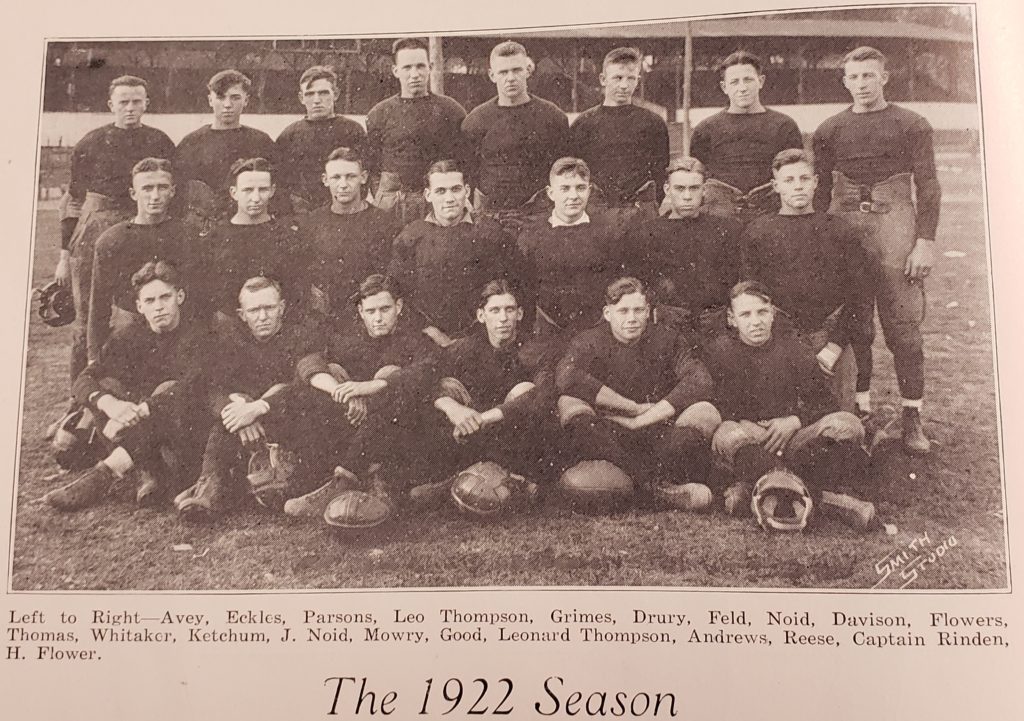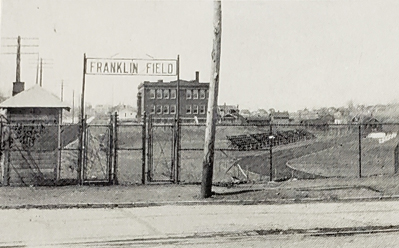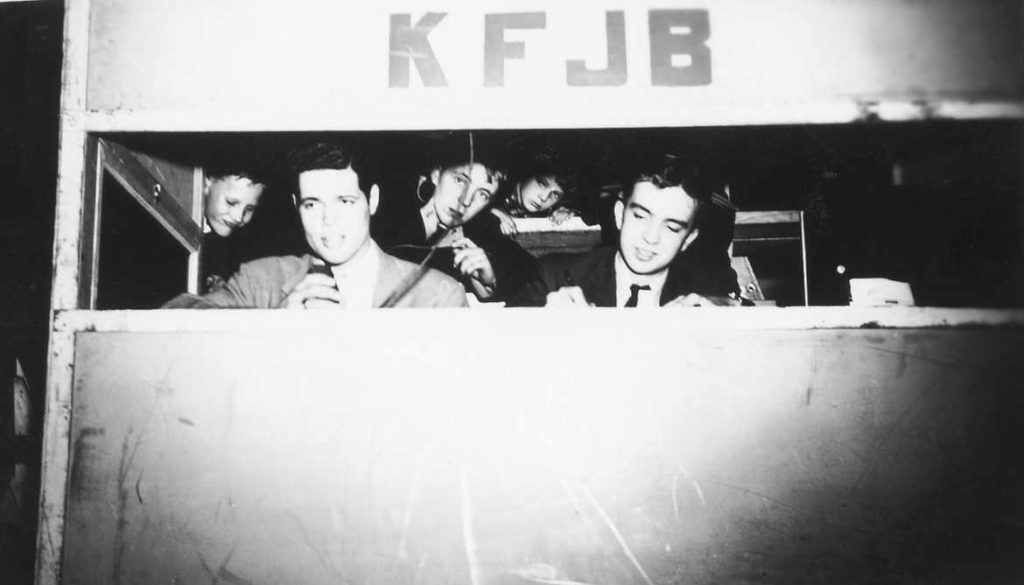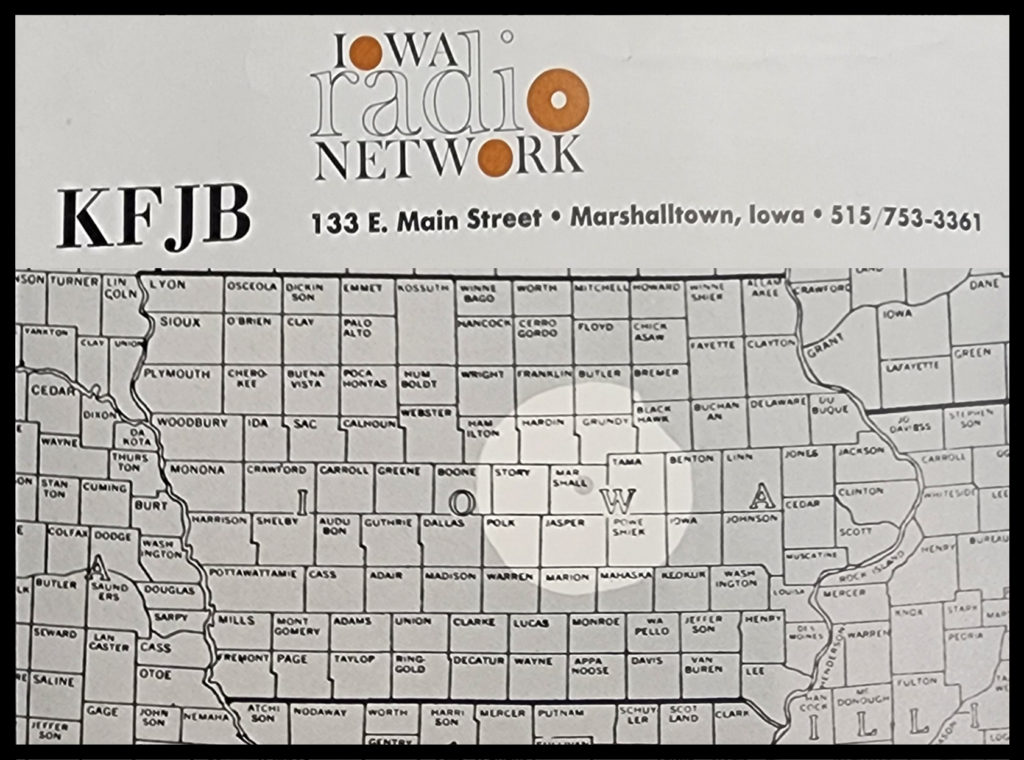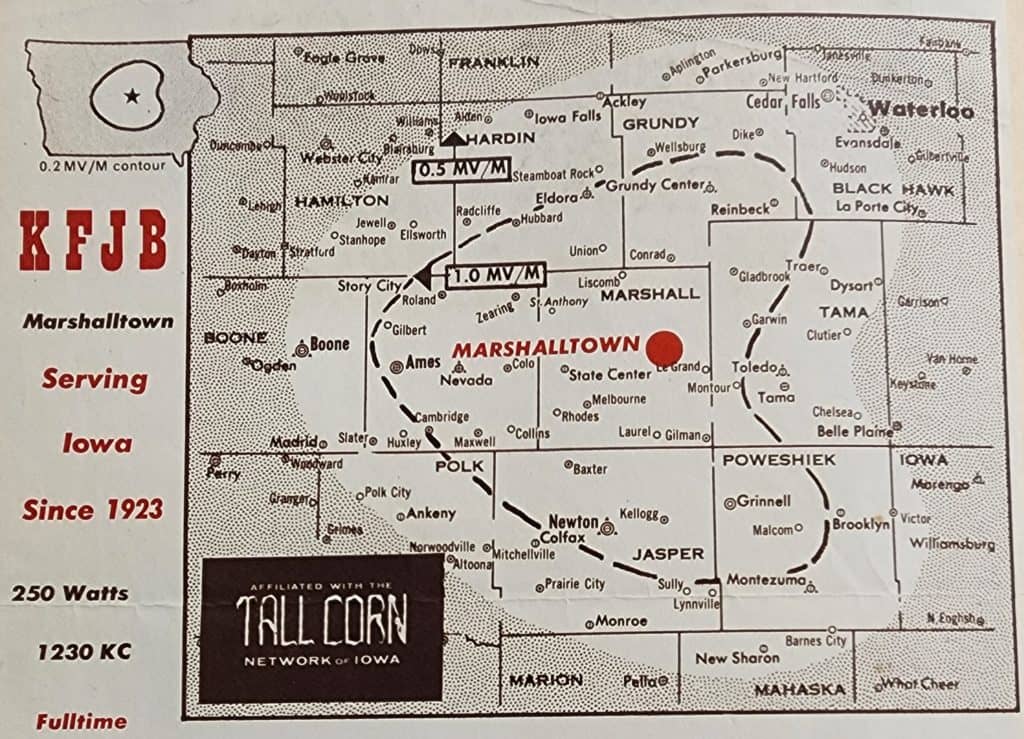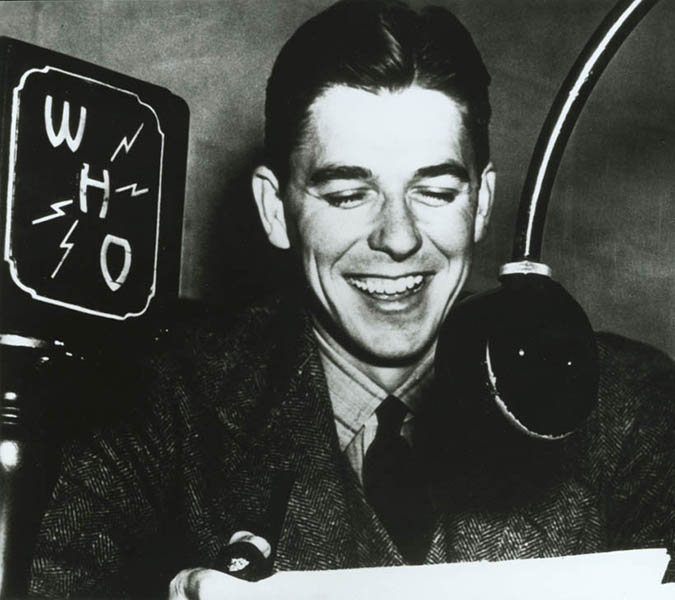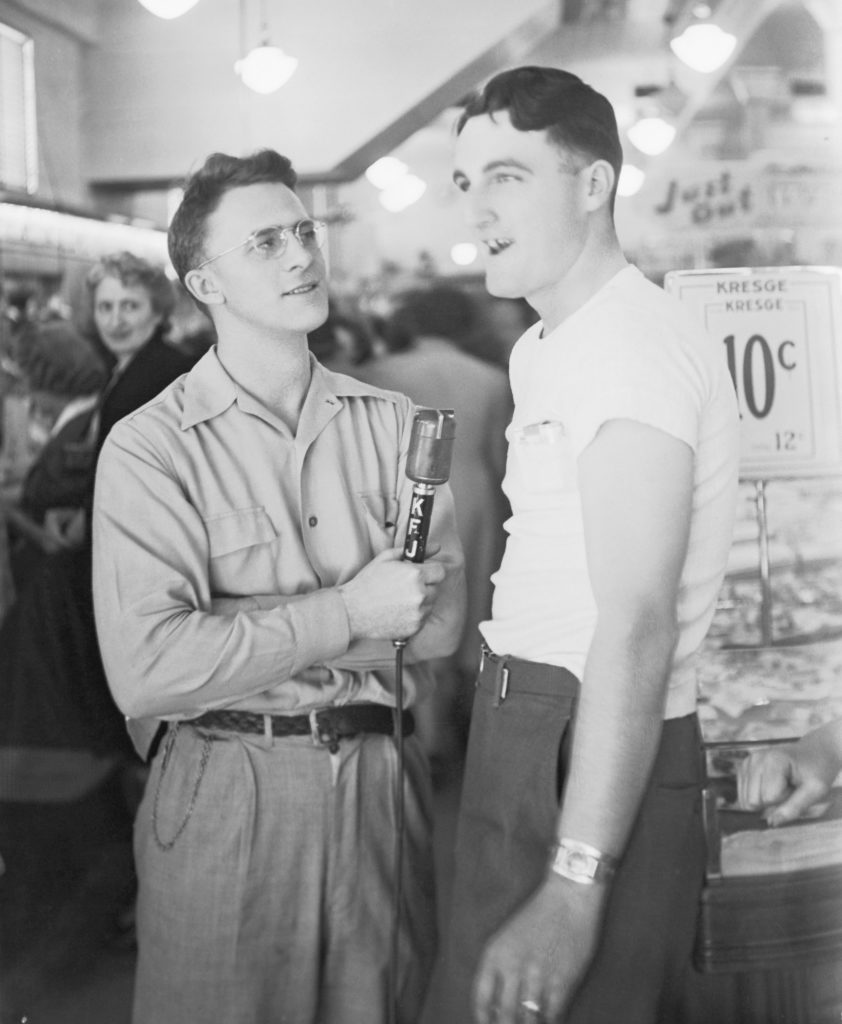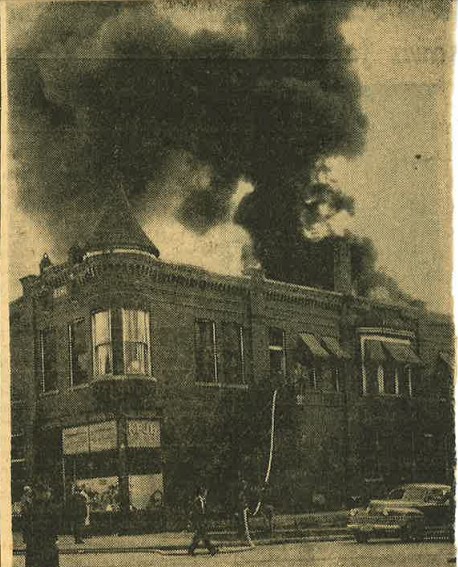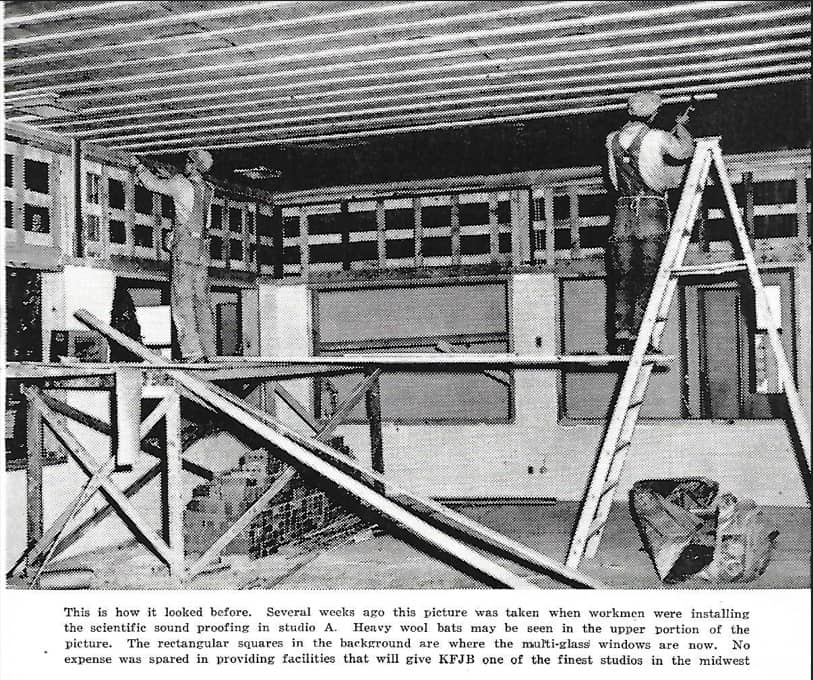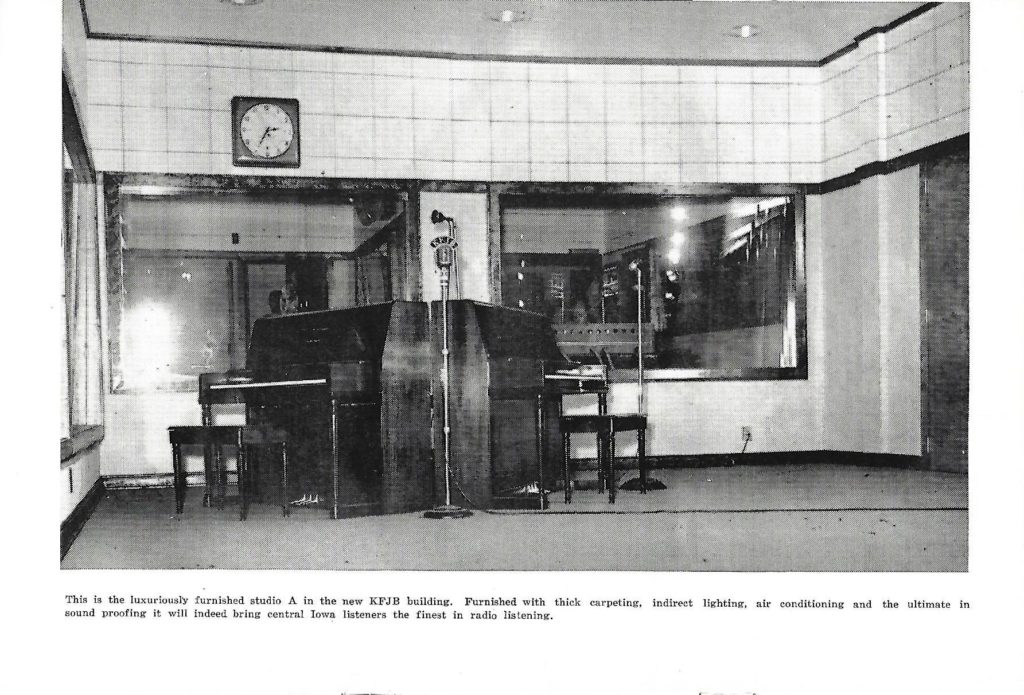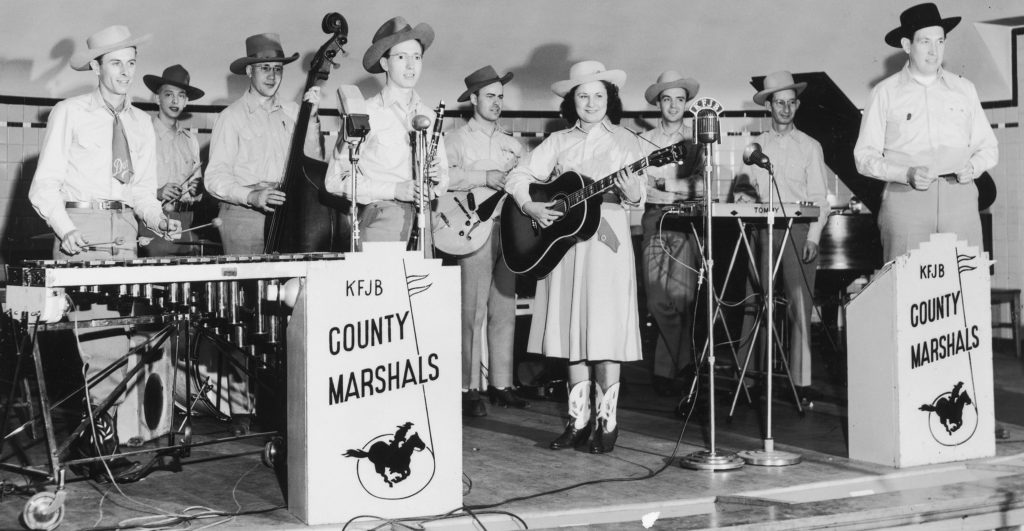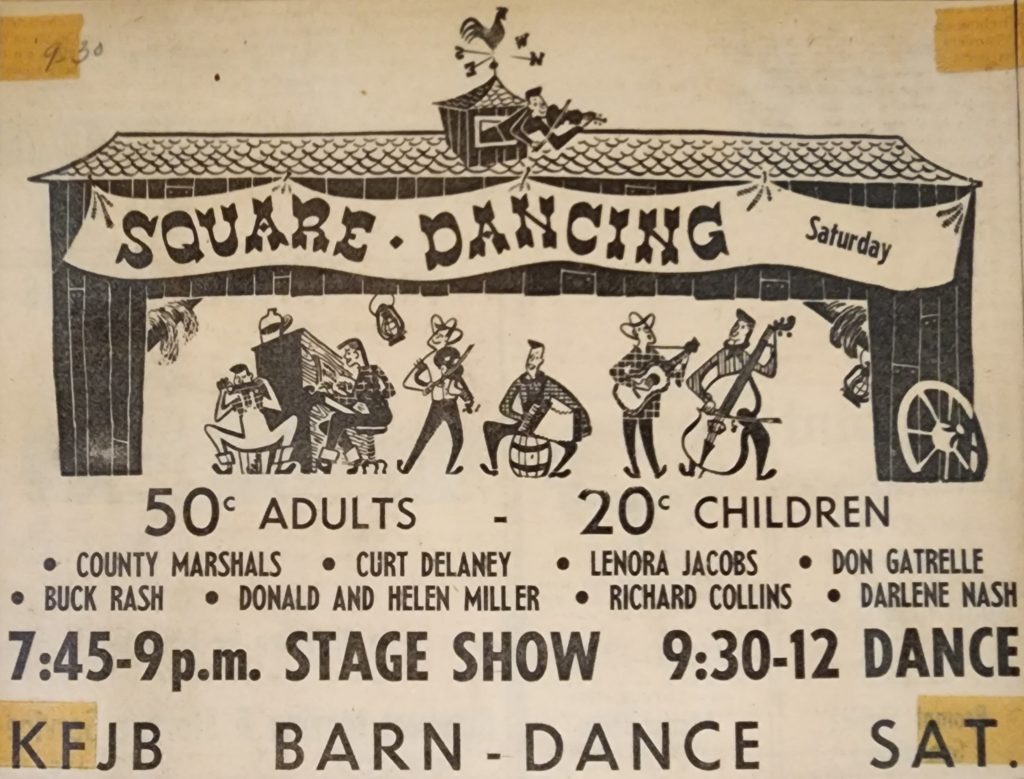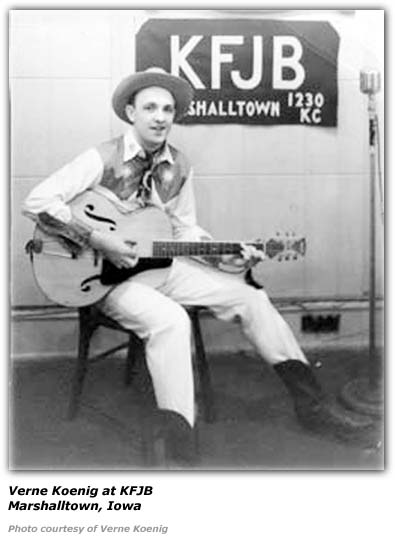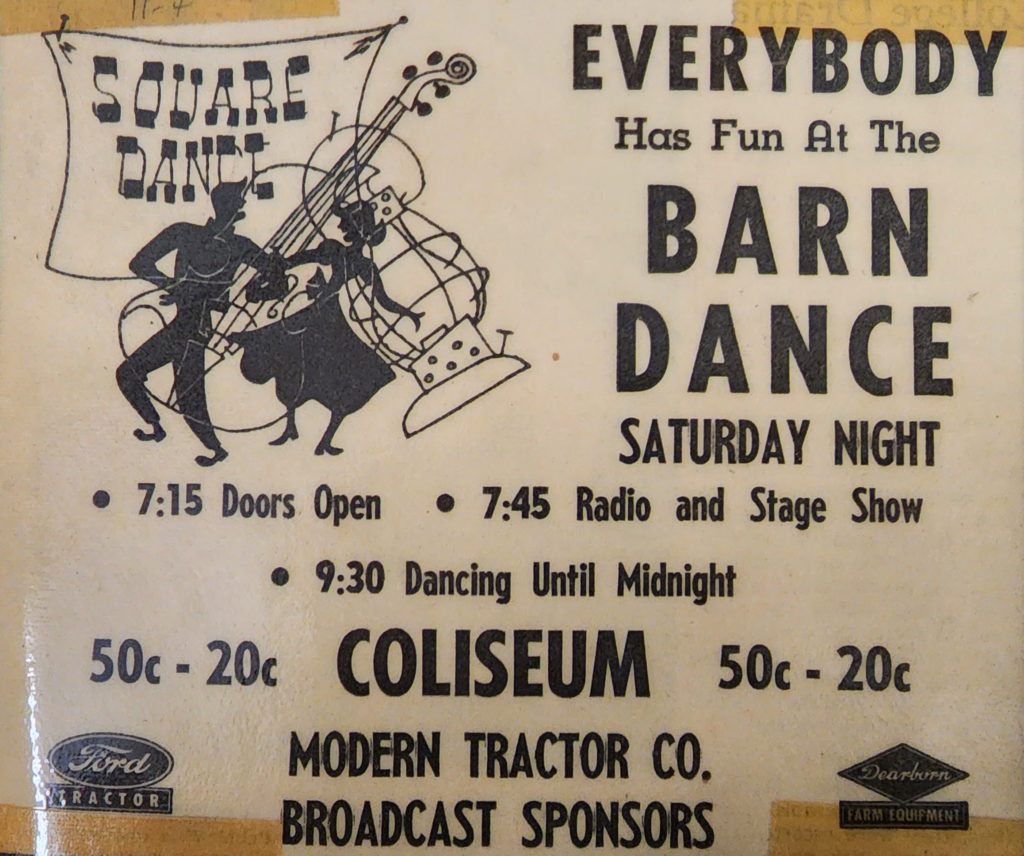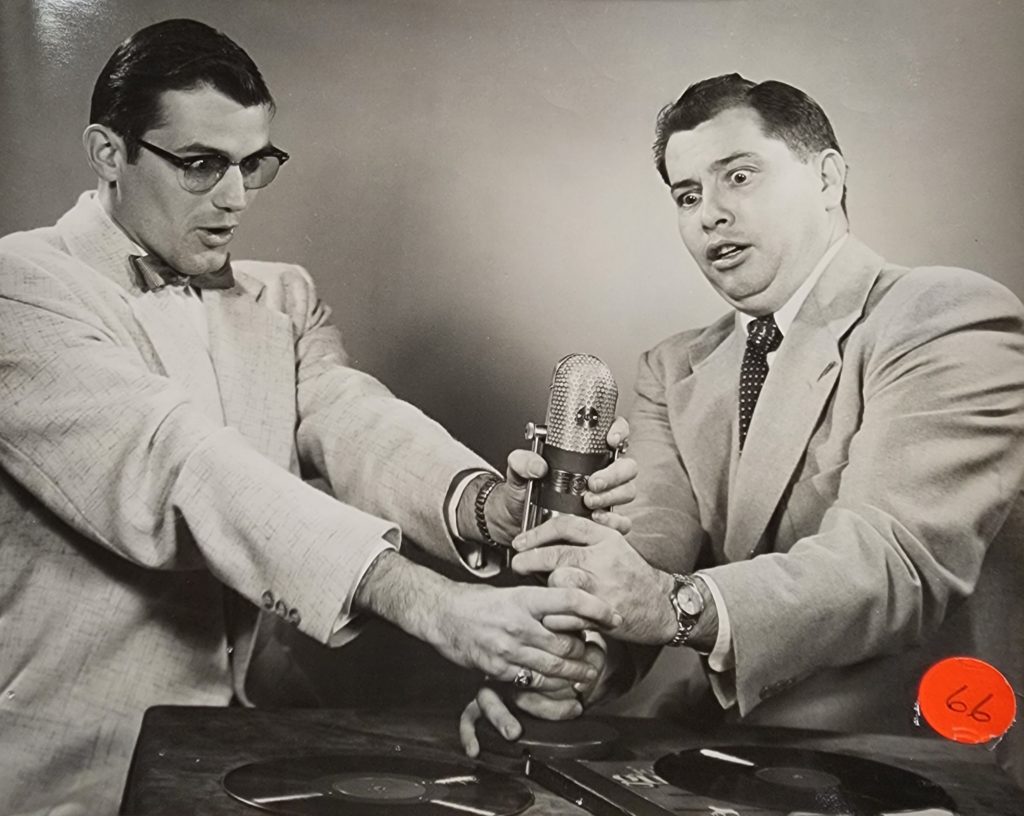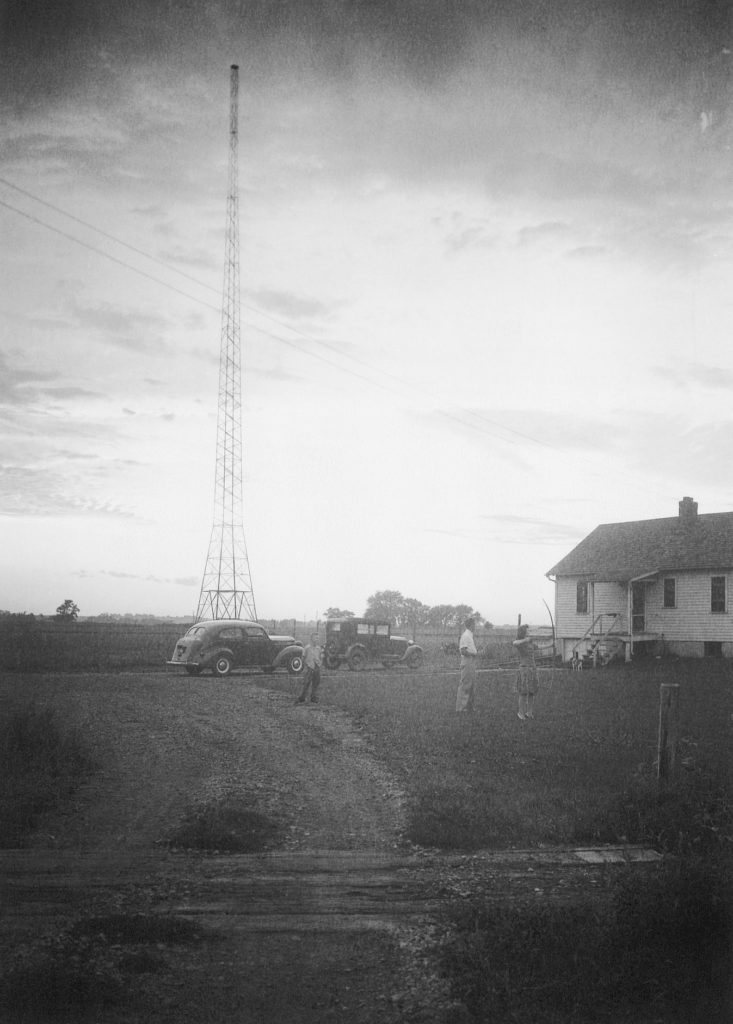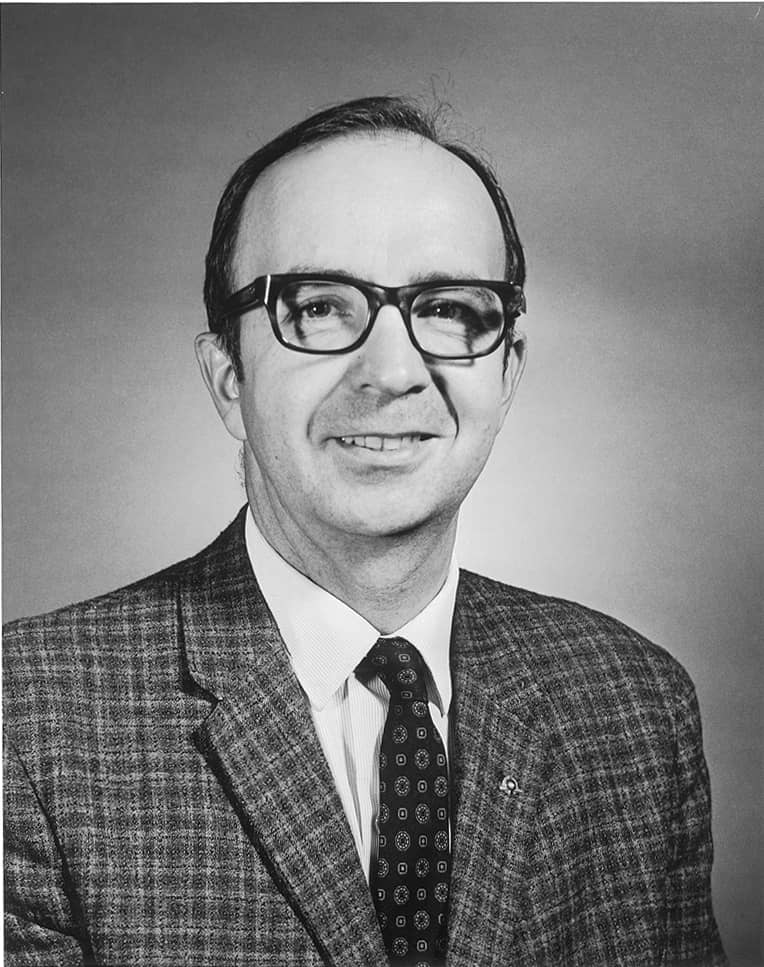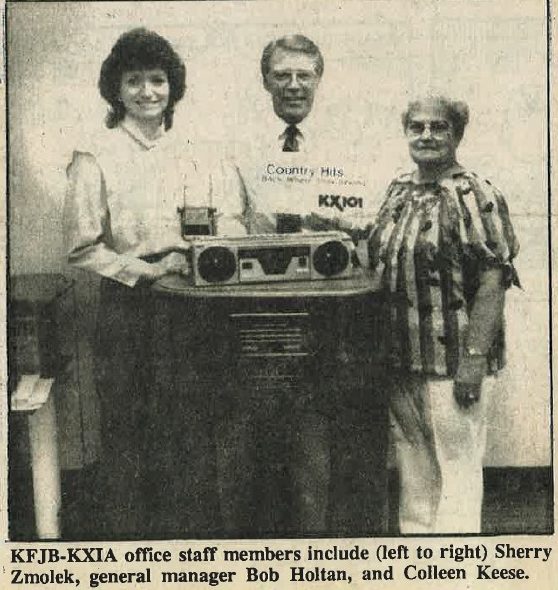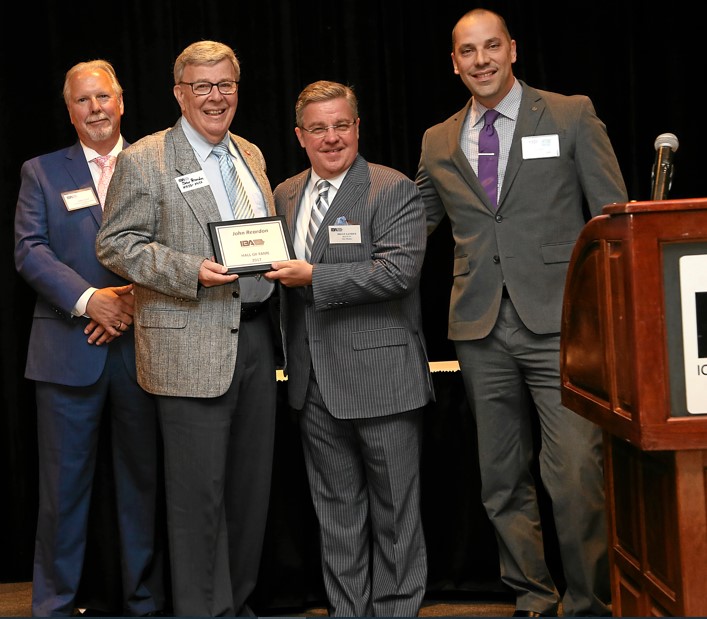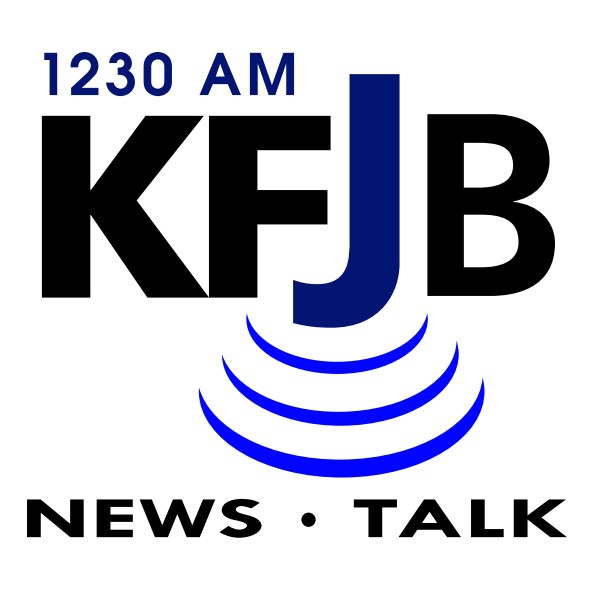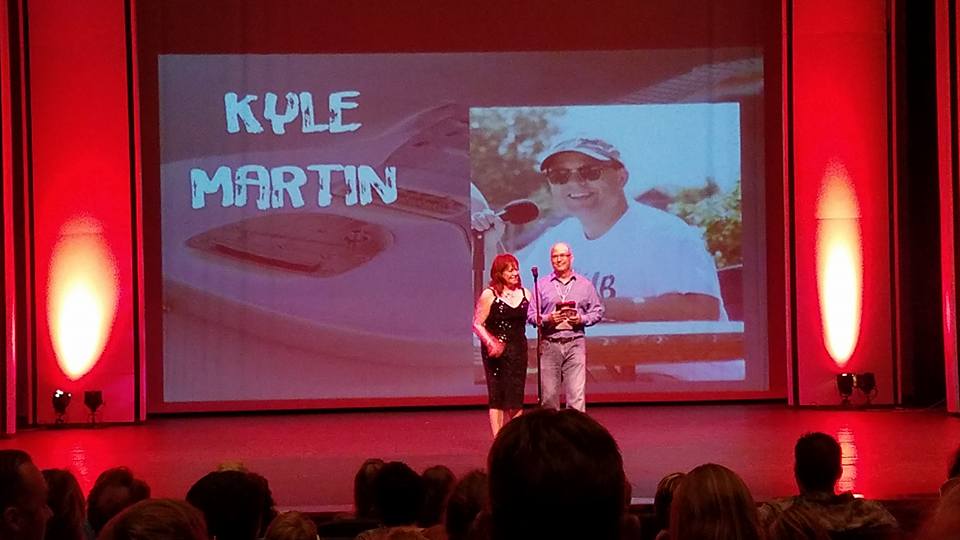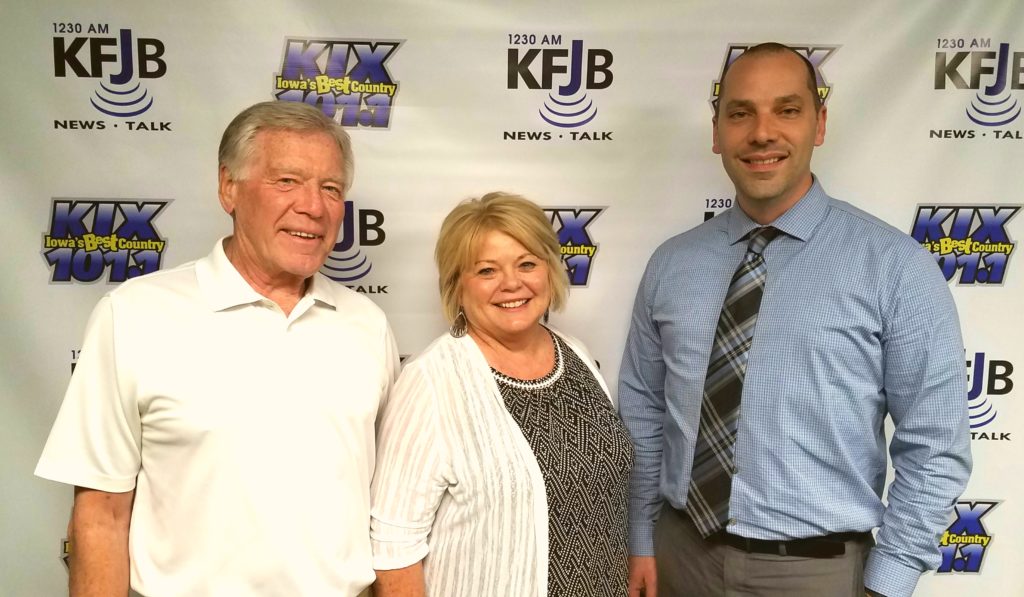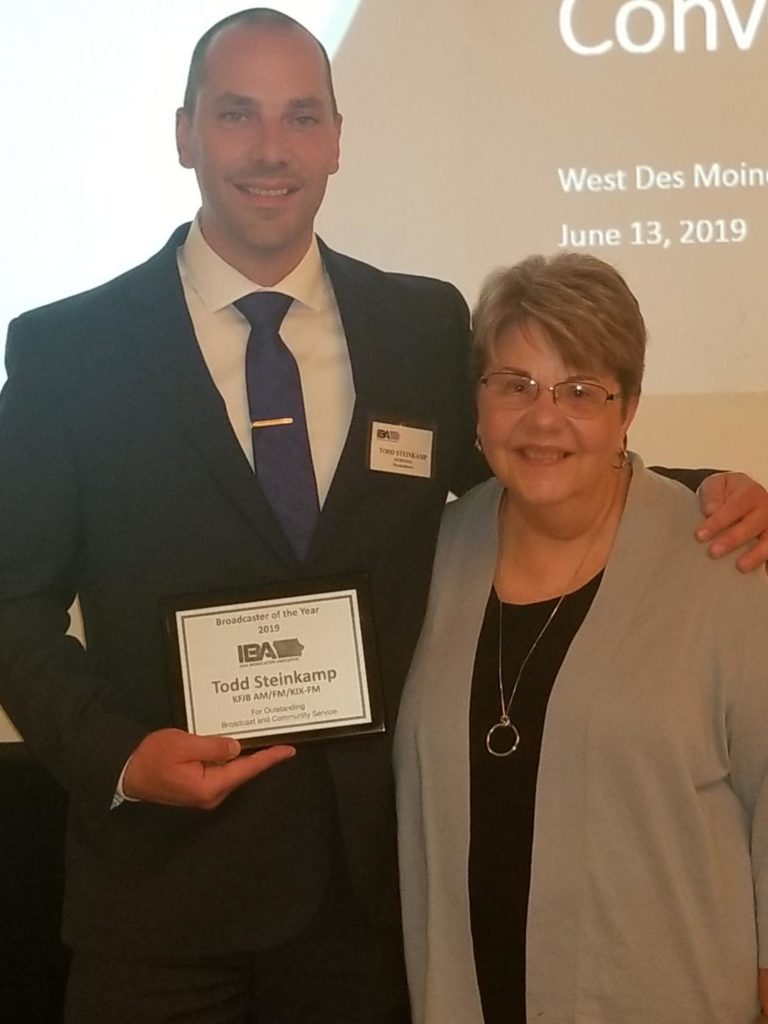The History of KFJB Radio, Marshalltown Iowa
KFJB is one of the pioneers in radio broadcasting dating back as early as 1919. The following history is a culmination of current and former employee interviews and conversations, company records, audio recordings and newspaper articles. It by no means encompasses every detail about KFJB. If you have additional information including articles, tapes, records, pictures or memorabilia please contact us so that we may possibly add it to the storied history of KFJB.
KFJB was founded by the late Earl Peak who operated Marshall Electric Company. His interest in commercial radio was kindled more out of curiosity than practicality, for Peak’s primary concern at the time centered around rural and commercial electrification. In a fourteen-year period, Marshall Electric Company constructed 500 miles of rural transmission lines, wired thousands of residences and small buildings, electrified over twenty Central Iowa towns and was responsible for the wiring of many large power and factory installations including Lennox Furnace Company, Fisher Governor, and the State Reformatory at Anamosa.
Headquarters for the Marshall Electric Company operation was a wooden structure located at 1603 West Main Street, which ultimately became the business and studio of an early KFJB.
Chauncy Hoover along with Merle Easter (employees of Marshall Electric) played a large role in the technical aspects of launching KFJB. According to Chauncy, sometime between 1919 and 1921, Merle put a ham radio rig out in the back room at Marshall Electric where he could get on the air with very little line noise or interference, since the building was located on the west end of Main Street with little around it. One-day, Peak came out to where the ham radio set was and said, “boys can you build me a broadcasting station?” They told him they could, because they had built ham transmitters. They built the transmitter, put up an antenna on the west side of the building on telephone poles and so it was that KFJB was built from composite parts and put on the air.
As a still experimental radio station, but wanting to highlight events throughout Marshalltown including ever popular Marshalltown High sporting events, Earl Peak had the idea of broadcasting a sporting event live. At that time, the only way to put sporting events “on the air” was to have someone at the game use a telephone and describe the action to an announcer back at the studio. The announcer would then speak into the microphone and describe what was being told to them over the phone. However, On September 23rd, 1922 staff at Marshall Electric / KFJB built and then ran a three block long microphone cable through the studio window and along West Main Street to Franklin Field at the corner of 13th and Main. Two Marshalltown football games were broadcast live that afternoon. The Marshalltown High School Bobcats defeated the Plainsmen of Belle Plaine 32-0 in the first game and then shut out the Toledo Raiders 28-0 in the second game. On that fall day, KFJB became the first radio station to broadcast a football game live from the field in the United States from Franklin Field in Marshalltown, Iowa.
KFJB sports crews carried a cumbersome booth consisting of portable sides, front and a top which fastened together, box like, with only the back of the booth open. This unit, perhaps six feet long and five feet high, would be assembled on the bleachers at either football or basketball contests as a means of keeping unwanted sound and curious hands from interfering with the broadcast.
On June 2, 1923 KFJB was commercially licensed by the US Government and is recognized as the 17th radio station on the air in the United States. Ten watts of transmitting power was authorized.
KFJB is regarded as one of the oldest stations west of the Mississippi river and has broadcast continually since June 2, 1923 on a licensed basis as well as experimentally prior to that time. Only a handful of Iowa radio stations were licensed prior to 1923 when the government assigned Earl Peak his license and the call letters KFJB. In later years, station owners would ask for specific combinations of letters in their call signal, to aid in the promotion of their facility. The letters KFJB were selected without specific purpose and had no particular value as a promotional tool.
KFJB was authorized a power increase to 15 Watts and by August of 1927 The Federal Radio Commission, a subsidiary of The Department of Commerce, granted KFJB I00 Watts of power on the frequency of 1210 Kilocycles and unlimited air time. This changed a few times over the years and in 1941, The FCC changed the KFJB dial location for the final time as it was assigned the frequency of 1230 Kilocycles which remains the frequency to this day with power increased to I,000 Watts in 1965.
In due time, the front portion of the Marshall Electric building at 1603 West Main, was converted to offices and broadcasting studios.
Announcer Don Hopkins recalls working for fifteen dollars a week in 1935. He further remembers, “I worked with a carbon microphone and after several hours on the air, the particles of carbon would become compacted. Then it was necessary to turn off the juice, hit the microphone with a ruler to shake the particles loose from each other so the mike would work.”
Some of the early voices on the station prior to World War II included familiar names such as:
Chuck Cook, Bob Weitzell, Don Hopkins, Bill White, Max Smith, AI Schrock, and many more. A very familiar face and voice that did not appear on KFJB was future President of the United States, Ronald Regan. Reagan applied for a job at KFJB in the early 1930’s. However, he was not hired as an announcer.
World War II was a difficult time for all including KFJB. The big problem was staff, as virtually all of the pre-war personnel had joined the military. Earl Peak was able to recruit two Marshalltown women who, with absolutely no previous experience, were able to assume announcer responsibilities and as such become the first routinely heard female voices on KFJB. They were Helen Alexander and Bernie Stepanek.
The popular “Man On the Street” program on KFJB started in the 1930’s and had broadcasts from Bliss Anderson’s Pool Hall and Soda Fountain along with it originating from the S.S. Kresge store on Main Street in Marshalltown and Strand Baking Company. Man on the Street was discontinued during the span of World War II at government orders. It was presumed informal and unrehearsed Man On the Street type programs could provide a vehicle by which enemy information might be disseminated. The program ended in 1980 but resumed in the summer of 2002 and has been happening ever since.
On January 31,1945, Earl Peak passed away at the age of 56. The death of Peak resulted in an immediate change of ownership. Four Des Moines businessmen, apparently in a receivership, assumed control of KFJB. They were: John Ruan and Robert Root of Ruan Oil; Joseph Rosenfield, an attorney, and Kenneth Durham. Representing the Des Moines purchasing group was Edwin F. Buckley, then president of the Central National Bank and Trust Company of Des Moines.
December 2, 1946 was a KFJB milestone. On that date a contract was signed requesting a change of ownership of KFJB from the group of Des Moines businessmen to the Times Republican (TR) Printing Company of Marshalltown, Iowa. The Federal Communications Commission finally approved the sale on April 18,1947.
Less than two months after the T.R. purchase, the sewer backed up at the studios. The mess prompted the new owners to make a decision that was unplanned but necessary. On June 9, 1947, the station left 1603 West Main forever, and moved to 136 West Main to what was known as the Batesole building, directly across the street South of the Times Republican.
In November 1948 on Armistice Day, a fire broke out near a ventilator fan on the roof of the Batesole building. Dark black smoke was visible for several blocks and the Times Republican reported “…even though fire badly damaged the control room and studio, not a minute (air time) was lost.” While repairs were being made, the station moved across the street to emergency quarters in the T.R. building.
During the interval in the Batesole building, the Times Republican obtained ownership of what had earlier been known as the Lay building at the southwest corner of East Main and Second Avenue. The building, with a street address of 133 East Main, had in earlier years housed a rather large department store. The architectural firm of Wetherell and Harrison of Des Moines drew plans for the new KFJB studios there which boasted nearly 5,500 square feet of floor space. Included in the concept was a large master studio measuring 33 by 18 feet and a smaller studio plus a control room, all adjoining and all centrally located, with offices on three sides. The studios were designed in such a manner that one could walk completely around them or access business offices as needed. There were ten office or shop rooms in addition to the glassed-in broadcast studios. On the fourth side, to the east, the architects designed an elevated visitors’ gallery where close to 100 folding metal chairs were placed in anticipation of visiting crowds. Three panes of heavy glass, set in felt, were included in all studio windows and the inside pane was tilted a few degrees downward to deflect sound waves onto the carpet. The ceiling and upper walls were of acoustical tile with thousands of tiny holes meant to absorb sound. Walls were filled with heavy insulation.
The shining new KFJB studios were formally dedicated on Friday June 24, 1949. Holding court at the ceremony was PauI Norris, representing the Times Republican and KFJB; R.S Stover, the Chamber of Commerce President, and Don Taylor, the mayor of Marshalltown. During the following Saturday and Sunday, June 25 and 26, during a public open house, over 6,500 people visited the new KFJB studios, including future movie star and Marshalltown native, Jean Seberg. She signed the guest book. Broadcasting would continue at those studios for the next 33 years. (Unfortunately, the building burned down on December 13th, 2011.)
KFJB embarked upon a promotional plan that lasted several years and proved to be of enormous public relations value. It was called KFJB Special Events and included two concepts;
1. The booking of “name” dance bands and / or entertainers and 2. The KFJB Barn Dance.
The Barn Dance, or technically Tallcorn Varieties, was essentially built around a studio band which provided the entertainment nucleus of an hour-long Saturday night live show and broadcast on KFJB which originated from Memorial Coliseum or occasionally from the second floor of the V.F.W. Building. Additionally, an amateur contest was held within the show, and three or four local acts would appear and be judged by applause. The staff band that would consistently perform at the KFJB Barn Dances were the County Marshals.
The County Marshals provided music patterned after that of the big bands but also drew heavily from the Country-Western field and at one time or another there was always a square dance, a circle dance, a butterfly dance and a waltz.
For the booking of “name” dance bands and / or entertainers, KFJB booked such names as Sammy Kaye, Jimmy Dorsey, Frankie Carle, Spike Jones, Blue Barron, Tiny Hill, Eddy Howard and several others. As with the Barn Dance, the station rented either the Memorial Coliseum or the V.F.W. after which the event was heavily promoted and tickets were sold at the door. KFJB usually broadcast a thirty minute live remote during the course of the evening. On the final booking, May 5, 1955, the station featured Guy Lombardo. Also on the bill that night was ventriloquist Jimmy Nelson along with recording artists, “The Taylor Maids.”
As the years went by, then manager of KFJB, Bill White, saw fit to add to the staff. One of the largest groups was in 1956. At that time the following people were on the KFJB staff; Bill White, manager; Bill Doll, sales manager; Dale Smith, Program Director; Howard Vint, Farm Director; Herb Anderson, Chief Engineer; Al Schrock, News Director; Pearl Carter, Office Manager; Barry Norris, Jim Eddingfield, Curt Palmer, Ted Bishop, Steve Ridenour, and Jerry Gregson, Announcers; Evelyn White, Reception and Traffic; Herb Castorf and Bill Nowasell, Engineers; Irma Walton and Caralee Anderson, Continuity; Mabel Livingston, Bookkeeping; Pauline Van PeIt, Music Librarian and CarI Ulery, Sales.
During August 1961, a raging storm passed through Central Iowa. Winds clocked at 55 miles per hour toppled the KFJB transmitting antenna located northwest of town. The 231-foot free-standing steel tower was totally destroyed. A new steel tower, this time guyed with heavy cables, was up and running less than a week after the storm and is still in use today.
Before FM radio was nearly as popular as it is today, the management of KFJB wrestled with the notion of applying for a license. Prodded somewhat by staff members and with the realization that there was great potential in FM, manager Bill White took his case to the station ownership. They agreed, and KFJB applied for and received a license to operate at 27,500 Watts of power at 101.1 on the FM dial. The new station took the air January 23, 1968 operating 7:45 a.m. until 11p.m. Monday through Saturday and 8 a.m. until 11 p.m. on Sunday. Initially, the station was identified by the call letters KFJB-FM.
For a short time in the early 1980’s, the FM station was assigned the call letters KMTG which stood for “Keep Marshalltown Growing.” KMTG, an Adult Contemporary station, became KXIA with a Country music format in June, 1987. KFJB was an Oldies station at that time, and in the Summer of ’87, began a series of live Oldies shows at the Coliseum. KXIA also produced and promoted some live shows in Marshalltown featuring local and National Country artists beginning in 1988.
Allan Schrock, was named new manager of KFJB and KFJB-FM on January 1, 1979. AI, whose background at the Marshalltown station included stints as News Director, Program Director and Assistant Manager, assumed the reins at a time when the station ownership was finalizing plans for construction of new studios. Plans for the new studios were drawn by Gethmann Construction Company, calling for 4,600 square feet of space in the lower level of the Commercial (Hawkeye) Bank Building located at 123 West Main Street. This is the current location of the KFJB studios.
The new home for KFJB and KFJB-FM was completed almost a year later and the staff moved into their new quarters in mid-December, 1979. The move included the installation of several pieces of new equipment and the move to stereo broadcasting on the FM side.
The Times Republican ownership of KFJB continued for another seven years when in September of 1986 David Nelson and partners applied for FCC approval to purchase the stations. Al Schrock, concluded his service with KFJB on October 26, I986, when he announced his retirement.
On December 29, 1986, Marshalltown Broadcasting, Inc. took ownership of KFJB and KMTG. Bob Holtan, one of Nelson’s broadcast partners, became manager of the stations.
Holtan remained as station manager until July of 1989. At that time John Reardon (a future Iowa Broadcasters Association Hall of Fame recipient) came from KBIZ in Ottumwa and took over as manager and held that position until 2001.
In June of 2001, after 44 years in the radio industry, John Reardon retired. With his departure Clark Wideman, who had worked for David Nelson in other radio and television markets was named station manager. Later that year on September, 11th 2001, an attack of the United States would start a conversation in shifting the format of KFJB.
In January 2002, KFJB became “News Talk 1230 KFJB”, switching from an oldies music format into News Talk. As the nation was reeling from the September 2001 terrorist attack, it also was craving more news and information to keep up with what was happening and the format change helped feed that desire to the listeners.
Over the years, KFJB has featured some of the greatest on-air talent with many already being mentioned. That tradition continued on February 12th, 2004, Kyle Martin joined KFJB as the morning show host and Program Director. At the time of KFJB’s 100th anniversary, Kyle continues to host the morning show and has become a staple on the airwaves. In 2017, Kyle’s years of broadcasting and hard work was recognized as he was inducted into the Iowa Rock & Roll Hall of Fame.
On April 4, 2016, Clark Wideman retired after 15 years as station manager for Marshalltown Broadcasting. Todd Steinkamp was appointed to take over the position. Todd had been with the stations since 2003 with rolls as KXIA Program Director, morning show host and the companies Chief Operator.
On July, 18th 2017 the majority owner of Marshalltown Broadcasting, David L. Nelson passed away at the age of 96 after a long and respected career in broadcasting ownership. Not long after, Marshalltown Broadcasting made the decision put the stations of KFJB and KXIA up for sale.
Bob Holtan (who was manager of KFJB in from 1986 – 1989) was a minority owner of KFJB and KXIA under Marshalltown Broadcasting. Bob, along with his wife Colleen who also owned the radio station KDEC in Decorah, Iowa approached current General Manager Todd Steinkamp with the proposition of partnering and purchasing the stations of KFJB and KXIA. On February 8, 2018, Bob and Colleen Holtan along with Todd Steinkamp formed a new company called Trending Media. KFJB and KXIA were then purchased by Trending Media following approval from the Federal Communications Commission in July of 2018.
It was not long after Trending Media took ownership of KFJB and KXIA that they, along with the city of Marshalltown would face a traumatic event. Just after 4:30pm on July 19, 2018, an EF-3 tornado devastated the downtown and northern parts of Marshalltown. KFJB and KXIA on-air personalities as well as other staff members tracked the storms live and reported on the tornado as it hit the city and the radio studios. (audio of these broadcasts can be heard here). The tornado caused extensive damage to the downtown area and for the radio studios including the collapse of a 120-foot antenna, the destruction of two broadcast satellite dishes along with damage to station and staff vehicles. Thankfully the building was not severely damaged and no lives were lost throughout the coverage area. Over the following days, the stations ran via generator power and the entire staff came together to relay pertinent and lifesaving information to the citizens of Marshalltown. That coverage of the tornado and its aftermath was recognized by the Iowa Broadcast News Association. KFJB and KXIA were awarded with Excellence in Weather Coverage and Spot News.
Todd Steinkamp was also named Broadcaster of the Year by the Iowa Broadcaster’s Association in part to Todd’s efforts to keep both KFJB and KXIA on the air and the public informed in the wake of the tornado.
KFJB made another step in its broadcasting history when on May 10, 2021 it launched an FM translator. This FM translator simulcasts all programing from 1230 AM to air also at 93.9 FM. News Talk 1230 KFJB AM & 93.9 FM in turn was now able to bring its programming to an all new audience on the FM radio dial.
In 2022, KFJB celebrated 100 years of broadcasting Marshalltown Bobcat athletics. On September 23rd, 1922, KFJB was the first radio station to broadcast a football game live from the field in the United States from Franklin Field in Marshalltown, Iowa. And during the 100-year celebration, KFJB made yet another technological step in it’s already storied broadcasting history. In August of 2022, KFJB-TV premiered. KFJB-TV broadcasts Marshalltown Bobcat Athletics along with other local programming via numerous video platforms including www.1230KFJB.com, www.youtube.com/@KFJBTV, www.facebook.com/1230KfjbNewsTalk and https://twitter.com/KFJBTV. Play by play announcer Brandon Lewis along with color commentator Dylan Does not only announce the games on News Talk 1230 KFJB AM & 93.9 FM but now, allow people to watch all of the athletic events with high production value and multiple camera angles utilizing a large KFJB-TV video crew. KFJB’s goal was to grow and showcase Marshalltown Bobcat Athletics and its student athletes along with showcasing local businesses who wanted to also see the school and city of Marshalltown grow.
In 2023, KFJB celebrates 100 years of broadcasting as it was commercially licensed by the US Government and is recognized as the 17th radio station on the air in the United States on June 2, 2023. KFJB has served Marshalltown and Marshall County during that time and continues to do so.
KFJB truly qualifies it as one of this nations pioneer radio stations.
KFJB’s 100th anniversary broadcast that aired on June 2nd, 2023 includes audio from over 100 years on the air featuring the legendary Pig Races, Help your Neighbor, Man on the Street and more.
Plus, interviews with current and former Owners, General Managers, Dignitaries and Employees including:
- Governor Kim Reynolds
- Dr. Jeff Stein
- Gene Peak
- Kevin Pink
- Todd Steinkamp
- Al Schrock
- Bob Holtan
- Dave Norris
- JJ Allen
- Clark Wideman
- Mike Lindell
- Jerry Logan
KFJB’s 100th Anniversary Broadcast – June 2nd, 2023





